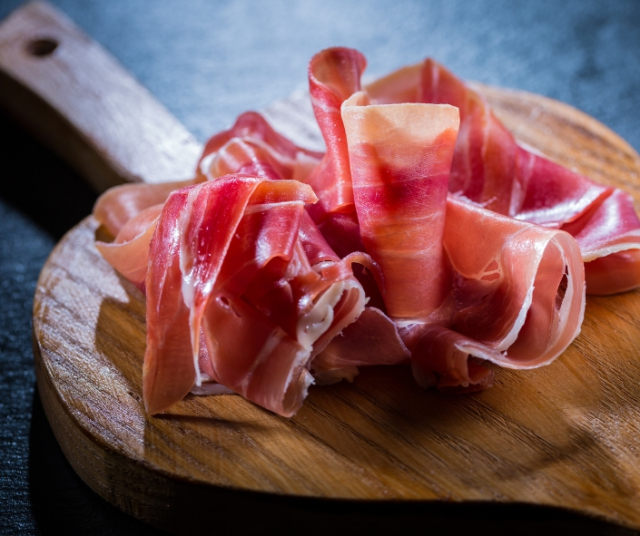Serrano Ham, a culinary icon of Spain , is a masterpiece of gastronomy that has delighted the palates of entire generations. With its unmistakable flavor and delicate texture, this delicacy has earned a privileged place on the Spanish table and has conquered the hearts of good food lovers around the world.
Origins and History
Jamón Serrano, whose name translates as "mountain ham," has its roots in rural Spain, where pig farming and sausage production have been deep-rooted traditions for centuries. The exact origins of Serrano Ham date back to ancient times, with records dating back to Roman times, when salting and curing meat were common techniques for preserving it.
However, it was during the Middle Ages when Serrano Ham began to acquire the reputation that has made it famous throughout the world. In the mountainous areas of Spain, especially in regions such as the Sierra Nevada, the Pyrenees and the Montes de León, farmers raised pigs freely, feeding them a diet rich in acorns, wild grasses and cereals. This varied diet, combined with the dry and cool climate of the mountains, contributed to the exceptional quality of the pork and the unique flavor of Serrano Ham.
For centuries, the production of Jamón Serrano was mainly artisanal, with each family or community following their own recipes and curing methods. However, as the demand for this exquisite product grew, small companies specialized in its production emerged, always keeping the legacy of traditional techniques alive.
Preparation of Serrano Ham
The preparation of Serrano Ham is a laborious process that requires patience, skill and a deep knowledge of pork. It begins with the careful selection of pigs, which must have suitable genetics and have been raised in optimal conditions. Once slaughtered, the pig's feet undergo a salting process, where they are covered with sea salt and left to rest for several weeks to remove moisture and preserve the meat.
After salting, the hams are washed to remove excess salt and left to air dry for a period that can last up to a month. This step is crucial to allow the meat to gain the necessary firmness before moving on to the curing process.
Curing is the longest and most delicate phase of the process, during which the hams are hung in special cellars known as drying rooms. Here, temperature and humidity conditions are carefully controlled to ensure uniform curing and proper ripening. For months, and even years, the hams are left hanging, slowly developing their characteristic flavor and intoxicating aroma.
Finally, when the ham has reached its optimal curing point, it proceeds to the aging stage, where it is allowed to rest under controlled conditions before being cut and packaged for sale.
Varieties and Designations of Origin
Serrano Ham is produced in various regions of Spain, each with its own distinctive characteristics that influence the flavor and quality of the final product. Over the years, several Protected Designations of Origin (DOP) have been established to protect and promote the authenticity and quality of Jamón Serrano. Some of the most notable DOPs include:
Teruel Ham: Coming from the province of Teruel, in the Aragon region, this ham is characterized by its soft and delicate flavor, a result of the unique climatic conditions of the area.
Trevélez Ham: Originally from the town of Trevélez, in the Alpujarra of Granada, this ham is distinguished by its intense flavor and soft, juicy texture, attributed to the altitude and cool climate of the region.
Guijuelo Ham: Produced in the Guijuelo region, in the province of Salamanca, this ham is characterized by its penetrating aroma and balanced flavor, the result of the combination of artisanal tradition and technological innovation.
These are just a few of the many varieties of Serrano Ham available on the market, each with its own unique characteristics that reflect the local terroir and production techniques.
Consumption and Traditions
Serrano Ham occupies a privileged place in Spanish gastronomy and is a fundamental element in numerous recipes and culinary traditions. From the classic ham and tomato sandwich to more elaborate dishes such as paella or stew, this exquisite product is used in a wide variety of preparations, adding a touch of flavor and distinction to each bite.
In addition to its use in cooking, Serrano Ham also plays an important role in celebrations and social events throughout Spain. Whether at weddings, parties or family gatherings, ham often takes pride of place on the table, where it is shared and enjoyed by friends and loved ones.
One of the most deeply-rooted traditions related to Serrano Ham is known as the "jamonada", a social event in which friends and family gather to taste and celebrate the quality of a good ham. During a jamonada, an expert ham cutter, known as a "professional cutter," cuts and serves the ham into thin slices, while guests enjoy the spectacle and savor each bite with delight.
Cultural and Economic Impact
Serrano Ham is not only a delicious food, but also a symbol of Spanish culture and identity. Its production is closely linked to the history and geography of the country, and its consumption is an integral part of the daily life of millions of people throughout Spain.
Furthermore, Serrano Ham plays an important role in the Spanish economy, generating thousands of direct and indirect jobs in the agri-food industry and contributing significantly to the country's trade balance. The export of Serrano Ham to international markets has also experienced constant growth in recent years, with consumers around the world recognizing and appreciating the quality and flavor of this unique product.
